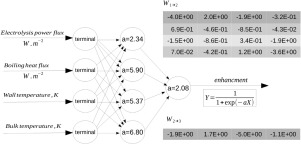Chemical Engineering and Processing: Process Intensification ( IF 3.8 ) Pub Date : 2020-02-01 , DOI: 10.1016/j.cep.2020.107818 S.A. Alavi Fazel , E. Lorzadeh

|
In this investigation, a novel technique for intensification of pool boiling heat transfer coefficient has been proposed. This method is applicable to electrolyte aqueous solutions at the isolated bubble regime. This approach is based on stimulating heating surface by DC electricity. In this condition, boiling and electrolysis phenomena performs simultaneously. Decomposed hydrogen and oxygen blends to vaporized water during boiling and provides extra bubble volume; moreover, active nucleation sites increase on the heating surface. Consequently, bubble dynamics including frequency, diameter and active nucleation site density are significantly affected. In this investigation, two opposing consequence from modified bubble dynamics have been observed: (1) enhanced heat transfer up to 40% as a result of increased active nucleation site density, bubble diameter and frequency at some low voltages of electrolysis, and (2) reduced heat transfer down to 70% because of an interconnected clusters of hydrogen/water vapor mixture which are attached on the heating surface at some high voltages of electrolysis. The experimental data were analyzed by artificial neural network and sensitivity analysis have been performed. The impact of bulk and wall temperatures, also electrolysis and heat power flux on heat transfer rate have been determined by sensitivity analysis. Results present that maximum enhancement of heat transfer coefficient is observed at about 1 kW m−2 electrolysis power flux. At wall temperatures above 290 K, no enhancement is observed by increasing bulk temperatures. Enhancement requires minimum boiling heat flux of 45 kW m−2.
中文翻译:

电刺激强化池沸腾换热
在这项研究中,提出了一种增强池沸腾换热系数的新技术。该方法适用于孤立气泡状态下的电解质水溶液。该方法基于通过直流电刺激加热表面。在这种情况下,沸腾现象和电解现象同时进行。沸腾过程中分解的氢气和氧气与汽化水混合,并提供了额外的气泡体积;此外,在加热表面上活性成核位点增加。因此,气泡动力学,包括频率,直径和活性成核位点密度都受到显着影响。在这项研究中,观察到了两个相反的结果,即气泡动力学的改变:(1)由于增加了有效成核位点密度,传热提高了40%。气泡直径和在某些低电压下的频率,以及(2)由于氢/水蒸气混合物的相互连接的簇相互连接,这些簇在某些高电压下附着在加热表面上,因此传热降低至70%。通过人工神经网络对实验数据进行分析,并进行了灵敏度分析。体积和壁温,电解和热功率通量对传热速率的影响已通过敏感性分析确定。结果表明,在约1 kW m处观察到最大的传热系数增强 (2)由于氢/水蒸气混合物的相互连接的簇在一些高电解电压下附着在加热表面上,使传热降低至70%。通过人工神经网络对实验数据进行分析,并进行了灵敏度分析。体积和壁温,电解和热功率通量对传热速率的影响已通过敏感性分析确定。结果表明,在约1 kW m处观察到最大的传热系数增强 (2)由于氢/水蒸气混合物的相互连接的簇在一些高电解电压下附着在加热表面上,使传热降低至70%。通过人工神经网络对实验数据进行分析,并进行了灵敏度分析。体积和壁温,电解和热功率通量对传热速率的影响已通过敏感性分析确定。结果表明,在约1 kW m处观察到最大的传热系数增强-2电解功率通量。在高于290 K的壁温下,没有发现由于整体温度升高而增强。增强要求最小沸腾热通量为45 kW m -2。











































 京公网安备 11010802027423号
京公网安备 11010802027423号